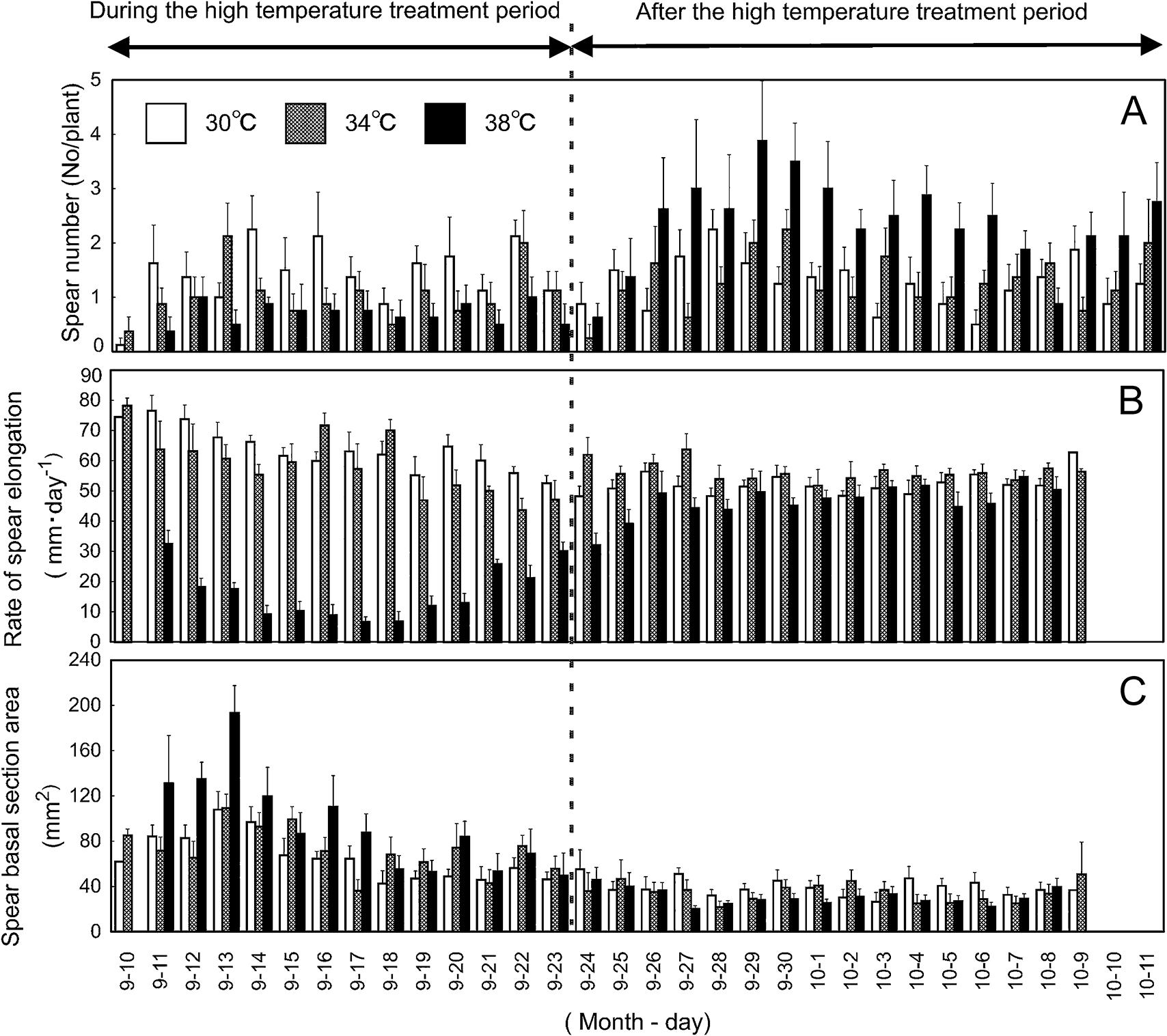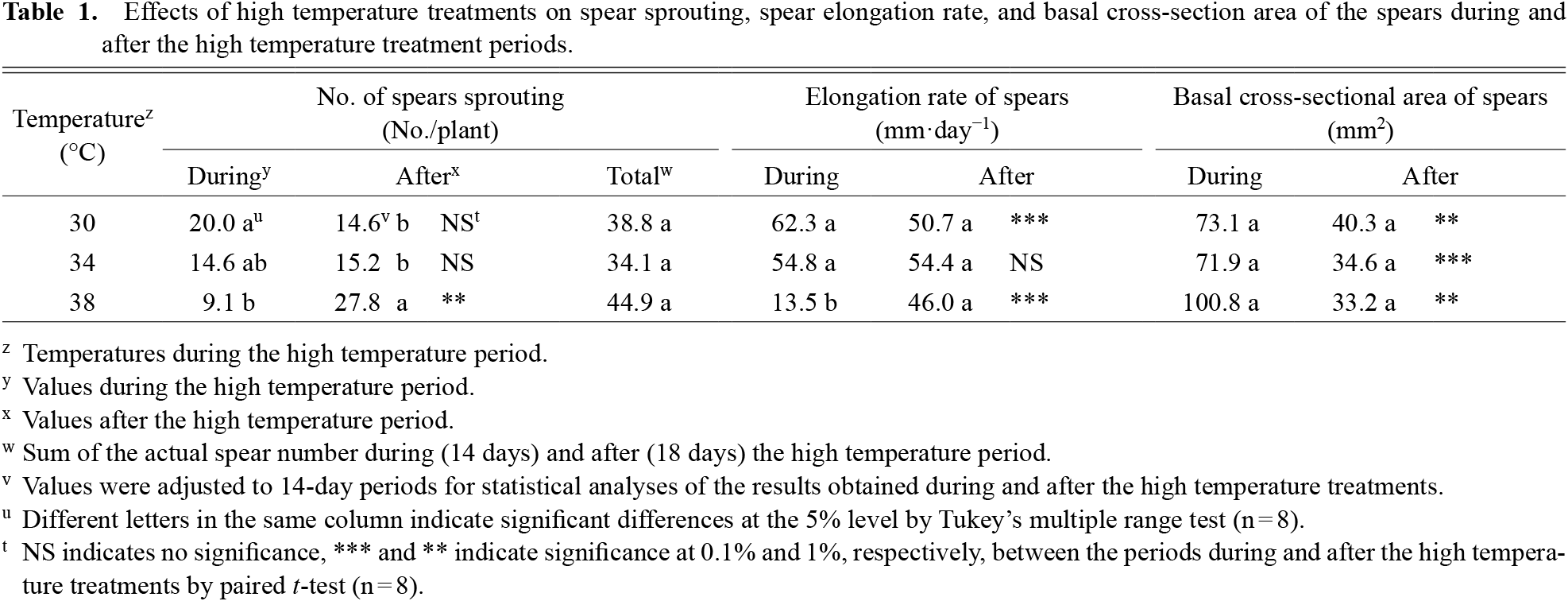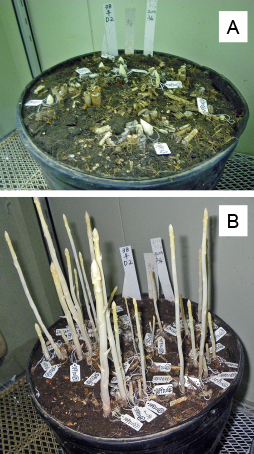2019 Volume 88 Issue 1 Pages 100-105
2019 Volume 88 Issue 1 Pages 100-105
In this study, we investigated the effect of high temperature on spear sprouting and elongation in asparagus to explore new approaches to control the harvest period in asparagus production. Four-year-old rootstocks of ‘UC157’ were grown in chambers in the dark at 30°C (30°C treatment), 34°C (34°C treatment), 38°C (38°C treatment), and 42°C (42°C treatment) for 14 days, and then at 25°C for 18 days. In the 42°C treatment, no spear sprouting was detected, and all rootstocks died. During the high temperature period, the number of sprouted spears was significantly lower in the 38°C treatment than in the 30°C treatment, whereas after the high temperature periods, the number was significantly higher in the 38°C treatment than in the 30°C and 34°C treatments. The total number of sprouted spears during and after the high temperature periods was not significantly different between the 30°C, 34°C, and 38°C treatments. The elongation rate of the spears during the high temperature period was significantly lower in the 38°C treatment than in the 30°C and 34°C treatments, whereas there were no significant differences in the mean spear elongation rate after the three high temperature treatments. These results suggest that a temperature of 38°C can be used to control spear sprouting reversibly by its application and cancellation.
Asparagus (Asparagus officinalis L.) is a perennial plant belonging to the Asparagaceae family (APG III, 2009), and the young spears from its rhizomes are eaten as a vegetable in the human diet. The spear yield is determined by the sum of the spear number and their individual weight. Given that the market price of spears fluctuates depending on the season, profitability for farmers could be enhanced by artificially controlling spear sprouting—suppressing spear sprouting during the low price period, but enhancing it during the high price period.
Sprouting and elongation of asparagus spears are affected by environmental conditions (Robb, 1984) such as soil moisture, gas environment, and temperature. Consequently, it was reported that the spear number decreases under drier soil conditions (Krug, 1998; Wilcox-Lee, 1987) and increases with irrigation (Roth and Gardner, 1990). Low concentrations of oxygen (Kitazawa et al., 2014) or high concentrations of carbon dioxide in combination with low oxygen (Kitazawa et al., 2016) suppress spear sprouting. There are many reports on the induction and breaking of dormancy by low temperature (Krug, 1996, 1999; Ku et al., 2007; Nie et al., 2016). Jishi and Araki (2013) reported that the harvest period of white asparagus can be extended by storage of rootstocks under snow mounds. Under high temperature conditions, the rate of spear elongation increased linearly with increasing temperature from approximately 10°C to 30°C (Clupepper and Moon, 1939; Kim et al., 1989), and the spear number increased as the temperature rose from 15°C to 25°C (Gąsecka et al., 2009). In a rootstock-planting forcing culture, dormancy of asparagus rootstocks induced by low temperature could be broken and spear sprouting facilitated by high temperature treatment from 26°C to 28°C (Yamaguchi and Maeda, 2015). In contrast, the number of sprouted spears and elongation rates decreased when rhizomes were exposed to 36°C as compared to those subjected to 33°C (Yen et al., 1996). It was also reported that at 35°C, the spear elongation rate slightly decreased compared to that at lower temperatures, whereas at 40°C spears sprouted but did not elongate and eventually decayed (Kim et al., 1989). These past reports imply that spear sprouting can be controlled by commencing or terminating the exposure of plants to sub-lethal high temperatures. Determining the range of high temperatures and the effect on sprouting may be utilized to develop a new control technology for spear sprouting during the hot season or in warm areas when the use of low temperature (cooling) is cost-prohibitive and thus not feasible.
In this study, we investigated the effects of high temperature treatments on spear sprouting and elongation in asparagus to explore new approaches for controlling the harvest period in asparagus production.
The experiment was carried out at the Kurume Research Station, Kyushu Okinawa Agricultural Research Center, NARO. Asparagus ‘UC157’ plants were grown in black polyethylene pots of 30.5 cm diameter and 17.9 L volume (TO Polypot with side hole No. 12; Tokai Kasei Co. Ltd., Mino, Japan). The pots were filled with compost of mixed field soil and weather-beaten cedar bark (Tenryo Eco Bark; Hita Resources Development Cooperative Association, Hita, Japan) at a 1:1 (v/v) ratio. Fertilization was conducted once a year at transplanting in the first year of the experiment, and in February and March starting from the second to the fourth year. Nitrogen, P2O5, and K2O were applied at a rate of 18.0 g, 16.2 g, and 18.0 g per pot, respectively, using controlled release fertilizers (Eco-Long 424 [180 days type] and CDU S555; JCAM AGRI Co. Ltd., Tokyo, Japan), along with 60 g per pot of organic calcium fertilizer (Ryujo-kudoseruka No. 2; Urabe Sangyo Co. Ltd., Hiroshima, Japan). Irrigation was performed several times a day using online drippers at a flow rate of 2.0 L·h−1 (PCJ-LCNL dripper; Netafim Japan Co. Ltd., Tokyo, Japan). Four-year-old plants were used in the experiment.
To avoid the effect of dormancy induced by low temperature on spear sprouting, the experiment commenced in September, when the mean air temperature was higher than 20°C. The ferns from the potted plants were cut just above the ground, and 8 pots containing 4 male and 4 female rootstocks each were placed in chambers at 30°C (30°C treatment), 34°C (34°C treatment), 38°C (38°C treatment), or 42°C (42°C treatment) and grown in the dark for 14 days (the high temperature treatment period). As the elongation rate of the spears is not retarded at temperatures below 30°C (Clupepper and Moon, 1939; Kim et al., 1989), the 30°C treatment was used as a control. After 14 days, the temperature in all chambers was reduced to 25°C and the rootstocks were grown in the dark for 18 additional days. During the experiment, air humidity in the chambers was not controlled, and plants were irrigated by hand to ensure that the moisture tension of the compost at 10 cm soil depth was more than −10 kPa. Air temperature of the chambers and compost temperature measured at 10 cm depth and 7 cm from the pot edge were recorded by data loggers (TR-71U; T&D Co., Nagano, Japan) every 10 min.
Spear sprouting was assessed every day during the experiment. The number of sprouted spears and their lengths were recorded daily along with the date and time of measurement. The length of each spear that was more than 15 cm by day 7 from the sprouting was measured, the date and time were recorded, and the spear was harvested. The same was repeated for spears that did not reach a length of 15 cm within the first 7 days from sprouting. The elongation rate of each spear per day was calculated by dividing the difference in spear length between the sprouting date and time and the harvesting date and time by the elapsed time between sprouting and harvesting. Basal major and minor axes of harvested spears were measured by digital vernier calipers (PC-15JN; Mitsutoyo Co., Kawasaki, Japan), and the basal cross-sectional area of the spears was calculated assuming that the cut end of the spears was an oval.
In the 30°C, 38°C, and 42°C treatments, the actual air temperature in each chamber and the compost temperature in the pots were very close to the set values (Fig. 1). The air temperature data in the 34°C treatment were not obtained because of a data logger malfunction. However, the measured compost temperature in the pots suggested that the air temperature was very close to the set value.

Time course of the actual air temperature and compost temperature in a pot in treatments at 30°C, 34°C, 38°C, and 42°C. Air temperatures were set at 30°C, 34°C, 38°C, or 42°C during the high temperature period, and reduced to 25°C after the high temperature period in all the treatments. Data pertaining to the air temperature were not obtained in the 34°C treatment due to malfunction of the data logger. Nevertheless, based on the compost temperatures in the pots in the same treatment, it was assumed that the air temperature was very similar to the set values.
In the 42°C treatment, no spear sprouting was detected during and after the exposure to high temperature. After the experiment, we confirmed that all the rootstocks were dead and in a process of decay.
The daily progress of spear sprouting in the 38°C treatment compared to that in the 30°C and 34°C treatments was slower during the high temperature period, but higher after the high temperature period ended (Fig. 2A). The total number of sprouted spears during the high temperature period decreased as the temperature rose; it was significantly lower in the 38°C treatment than in the 30°C treatment (Table 1). After the high temperature period ended, their numbers increased becoming significantly higher in the 38°C treatment than in the 30°C and 34°C treatments. When the total number of spears that sprouted during and after the high temperature treatment were considered, there were no significant differences among these three treatments. There was no difference in the number of spears that sprouted during and after the high temperature periods in both the 30°C and 34°C treatments, whereas a significantly greater number of spears sprouted after the high temperature period than during the 38°C treatment (Table 1, Fig. 3).

Effects of high temperature treatments on spear sprouting (A), elongation rate of the spears (B), and basal cross-section area of the spears (C). In B and C, data for 10-10 and 10-11 are lacking because the spears that sprouted on those days did not reach a length of 15 cm by the end of the experiment. The error bars represent the standard error.

Effects of high temperature treatments on spear sprouting, spear elongation rate, and basal cross-section area of the spears during and after the high temperature treatment periods.

Spear sprouting in the 38°C treatment during (A) and after (B) the high temperature treatments. The rootstock in A and B was the same. A, the rootstock at the end of the high temperature period; B, the rootstock 9 days after the high temperature period.
The spear elongation rate was low in the 38°C treatment compared to that in the 30°C and 34°C treatments during the high temperature period, but it was comparable among these three treatments after the high temperature period (Fig. 2B). The mean elongation rate of the spears during the high temperature period was significantly lower in the 38°C treatment than in the 30°C and 34°C treatments, whereas there was no significant difference in the mean spear elongation rate after the high temperature period among the three treatments (Table 1). The mean spear elongation rate during the high temperature period as compared to that after the high temperature period was significantly higher in the 30°C treatment, but significantly lower in the 38°C treatment. In the 34°C treatment, there was no significant difference in the mean spear elongation rate between the two periods, during and after the high temperature treatment.
The basal cross-section area of the spears was not significantly different among the three treatments during and after the high temperature periods, although the basal cross-section area of the spears tended to be wider in the 38°C treatment than in the 30°C and 34°C treatments during the high temperature period (Fig. 2C). The basal cross-section area of the spears was significantly smaller after the high temperature period than during the exposure to high temperature in all treatments (Table 1).
In this study, we present the possibility of controlling spear sprouting by using a high temperature such as 38°C. Both the number of sprouted spears and the spear elongation rate tended to be significantly decreased in the 38°C treatment compared to those in the 30°C and 34°C treatments during the high temperature period. However, the number of sprouted spears was significantly increased, and the spear elongation rate approached almost the same level as observed in the 30°C and 34°C treatments after the treatment period. These results showed that exposure of spears to a high temperature such as 38°C can be used to control spear sprouting reversibly. The detrimental effect of the 42°C treatment observed herein was similar to that reported in previous studies on asparagus spears that were exposed to 40°C (Kim et al., 1989). Taken together, these data indicate that asparagus rootstocks are unable to survive when exposed to a constant high temperature above 40°C for 5 days (Kim et al., 1989). In several crops, the base temperatures above which a physiological process stops (Tmax) and the lethal maximum temperatures (TLmax) were reviewed (Luo, 2007). For example, mean values ± SEs of Tmax and TLmax were above 20.9 ± 0.2°C and 47.5 ± 0.5°C in wheat (Porter and Gawith, 1999), 38.9 ± 2.8°C and 46.0 ± 2.9°C in maize, and 35.5 ± 0.5°C and 42.9 ± 0.7°C in rice (Sánchez et al., 2014). From the obtained results, the Tmax and TLmax of asparagus seemed to be around 38°C and 40°C, respectively, suggesting the difference between Tmax and TLmax is smaller in asparagus than those crops mentioned above. The factors that control for spear sprouting and elongation at high temperature should be taken into account to achieve both suppression of spear sprouting and prevent the plants from withering.
As the total number of sprouted spears during and after the high temperature periods showed no significant differences among the 30°C, 34°C, and 38°C treatments, the buds for which sprouting was suppressed during the high temperature period were able to sprout after the high temperatures in the 38°C treatment were withdrawn. Moreover, sprouting numbers per day increased for about 10 days to fill the shortfalls during the treatment. This shows that it is possible to control the number of spears harvested, i.e., increasing the amount during the higher price period and decreasing the amount during lower price period in the market. In freesia, cormlets could be stored for more than 200 days under a high temperature condition at 30°C (Doi et al., 2001), and Leucocoryne bulbs could be stored for 12 weeks under a high temperature condition at 30 and 35°C (Nakatsuka et al., 2018). As the effect of 38°C was tested for a relatively short period of 14 days in this study, further studies are needed to investigate the suppression effect of 38°C for longer treatment periods.
Spear sprouting and elongation were significantly suppressed but not completely stopped in this study. It was reported that young asparagus plants have a developmental phase that prevents them from acquiring the dormancy characteristic (Yamaguchi and Maeda, 2016). It was also reported that the changes in abscisic acid (ABA) content in large and small crowns during a high temperature period at 38°C were different; the ABA content in large crowns decreased gradually whereas the content in small ones increased (Fukuda et al., 2017). As there were crowns (bulbils) of different ages and sizes in the 4-year-old asparagus plants used in this study, the obtained results may reflect differences in responsiveness to high temperature of individual crowns (bulbils).
As mentioned above, strict temperature control is needed to apply high temperature treatment to field cultivation because there is only a slight difference in temperatures that induce suppression of spear sprouting and those which result in plant death. With the application of high temperature treatment, an indoor spear production system during the harvest period (Watanabe et al., 2012a, b) could be promising because it is easy to control the temperature during the harvest period and it would be possible to regulate sprouting more strictly in combination with controlling the gas environment (Kitazawa et al., 2014, 2016). For production in plastic houses, although it is difficult to control temperature accurately in comparison with the indoor spear production system, applying localized temperature control systems such as the crown-temperature control technique developed for strawberries (Dan et al., 2015) would be useful. In addition, concomitant use with spear sprouting retarding factors such as adding extra mother ferns (Jinno, 2014) and/or decreasing soil moisture (Krug, 1998), could be promising techniques to suppress spear sprouting and elongation in plastic house production.
In this study, we concluded that a high temperature of 38°C can be implemented to control spear sprouting reversibly by its application and cancellation. The findings are expected to be used as a new approach to control the harvest period in asparagus production.
The authors thank Mrs. M. Nagamatsu, Mrs. Y. Oka, and the trainees of the Kurume Development Training Course for their research assistance.